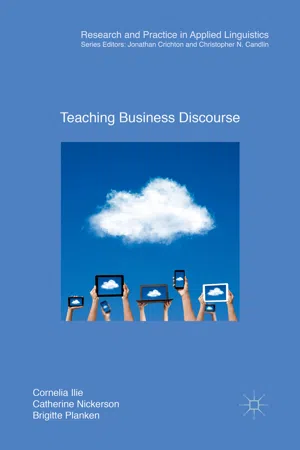- Define business discourse teaching as it will be referred to in the rest of this book;
- Discuss the most important approaches that have been taken in business discourse teaching;
- Give a geographical overview of how business discourse teaching has evolved around the world;
- Provide a case study that illustrates one approach to business discourse teaching, alongside a set of tasks related to the business discourse classroom and a set of further readings.

- English
- ePUB (mobile friendly)
- Available on iOS & Android
Teaching Business Discourse
About this book
This book presents research in business discourse and offers pedagogical approaches to teaching business discourse in both classroom and consultancy contexts that address the key issues of dealing with different types of learners, developing teaching materials and evaluation. Drawing on the authors' extensive experience of researching business discourse from a variety of different perspectives including pragmatics, discourse analysis, rhetoric, and language for specific purposes, it demonstrates how these approaches may be applied to teaching. Each chapter includes a list of additional readings, together with a number of practical tasks designed to help readers apply the materials presented. Case studies are used throughout the book to illustrate the concepts, thus equipping readers with a set of research tools to extend their own understanding of how language and communication operate in business contexts, as well introducing them to a variety of research-based ideas that can be translated easily into a classroom setting. The book is cross-cultural in scope as it includes perspectives from a range of different contexts. It represents a significant advance in current literature and will provide a valuable resource for students and scholars of applied linguistics, business communication, and business discourse, in addition to teachers of Business English.
Frequently asked questions
- Essential is ideal for learners and professionals who enjoy exploring a wide range of subjects. Access the Essential Library with 800,000+ trusted titles and best-sellers across business, personal growth, and the humanities. Includes unlimited reading time and Standard Read Aloud voice.
- Complete: Perfect for advanced learners and researchers needing full, unrestricted access. Unlock 1.4M+ books across hundreds of subjects, including academic and specialized titles. The Complete Plan also includes advanced features like Premium Read Aloud and Research Assistant.
Please note we cannot support devices running on iOS 13 and Android 7 or earlier. Learn more about using the app.
Information
1. What Is Business Discourse Teaching?
Table of contents
- Cover
- Front Matter
- Part I. An Introduction to Teaching Business Discourse
- Part II. Projects and Materials
- Part III. Business Discourse at the Practice-Classroom Interface
- Part IV. A Guide to Resources for Business Discourse Teaching
- Back Matter